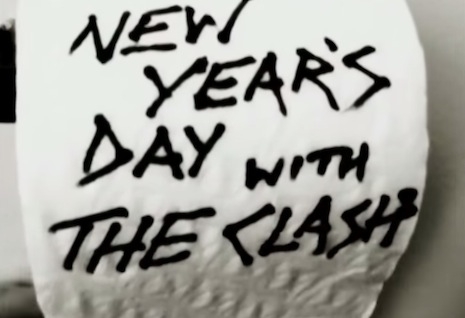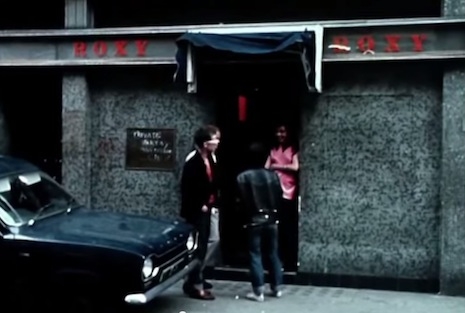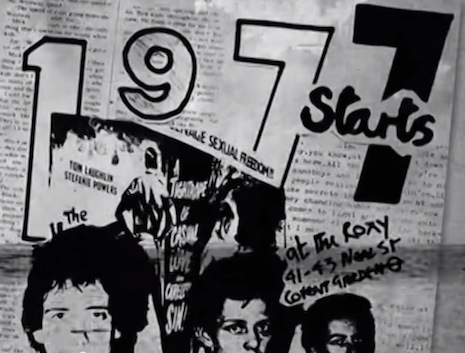
On the liner notes of their first LP Two Sevens Clash, roots reggae band Culture claimed that Marcus Garvey had prophesied that the date July 7, 1977, “when the two sevens clash,” would herald great conflagration. Whether Garvey said it or not (some hold that Culture just made the story up), it’s safe to say that 1977 was a year of great chaos. As the Clash sang around that time, “Danger stranger / You better paint your face / No Elvis, Beatles, or the Rolling Stones / In 1977.” The tumult of that year is amply demonstrated in 1977, a documentary by Julien Temple, director of The Great Rock’n'Roll Swindle and The Filth and the Fury, built around never-before-seen footage he shot of the Clash’s early gig at the Roxy on January 1, 1977, a gig that more or less ushered in both the Roxy and the Clash as punk fixtures, although the band ended up lasting a lot longer than the venue.

Temple’s documentary is a marvelous hodgepodge of footage covering U.K. anarchy in all its forms as the nation ushered in a tense new year. In the first few moments a fellow introduces a TV program in which every single member of the studio audience is named “Smith” by more or less declaring that the economic outlook in 1977 was likely to be lousy. Meanwhile, some other guy, on location at Stonehenge, welcomes in ‘77 by chugging some “champers.” The found footage of random British TV, which has nothing to do with the Clash, the Roxy, or punk, is every bit as fantastic as anything else in the movie.
As January 1, 1977, neared, the newspapers were full of “shocking” stories about punk, particularly the newly famous Sex Pistols. The Pistols and the as-yet-little-known Clash as well as Johnny Thunders’ Heartbreakers were in the midst of the Anarchy Tour, which was most notable for venues pulling out and cancelling gigs for fear of mayhem and adverse publicity. As Jon Savage wrote in England’s Dreaming, The Clash “were the true victors of the Anarchy Tour: benefiting from the publicity but not embroiled in controversy, they were the group to watch. To celebrate, Strummer specially customized a white shirt with a massive ‘1977’ on the front.”

The Roxy had recently been a “cheesy” gay club, to use Temple’s word, called Shaggarama. For the first three months of 1977, before the punk crowd moved on, the list of musical performers who played the Roxy is a veritable Who’s Who of Punk: The Buzzcocks, the Damned, Siouxsie & The Banshees, the Jam, the Stranglers, Sham 69, the Only Ones, Wire, the Adverts, X-Ray Spex, the Slits, XTC, and many more; even the Police played there. As Temple says, “With hindsight, the Roxy has taken on the aura of being vital to the early days of Punk, which may be an exaggeration. ... in fact the Punk crowd soon lost interest in it and moved on. The Roxy got worse and worse and lasted about 100 days.”

The Clash, having successfully introduced themselves in the Anarchy Tour, understood that they were on the precipice of something big. Their regular drummer, Terry Chimes (Strummer nicknamed him “Tory Crimes”) had gotten tired of the heavy-handed management style of Bernard Rhodes and opted out of the show. The Clash auditioned roughly 20 drummers in Camden Town, finally settling on Rob Harper, who was reportedly “scarred for life by the experience.” At the Roxy gig, they sang a new song, “I’m So Bored with the USA,” which wouldn’t see a studio recording until March.
As you watch the documentary, it becomes clear that Temple’s footage of that important New Year’s Day gig doesn’t really stand up on its own—you can find better Clash footage out there—which partially explains the strategy of buttressing it with huge chunks of highly resonant footage of U.K. during 1977. You see the Clash prepping for the show, you see lots of Malcolm McLaren and Johnny Rotten; Margaret Thatcher gets in there as well, of course. You see riots and reggae and regular Britons being staunch. It’s a great strategy, and the result is a terrifically diverting 75 minutes of punked-out bliss.
Be sure to watch it soon—this premiered on BBC Four just two days ago, and now it’s on YouTube—there’s no telling how long it will stay there.
via Include Me Out